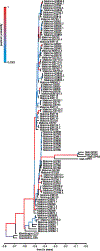Virology. Mutation rate and genotype variation of Ebola virus from Mali case sequences
- PMID: 25814067
- PMCID: PMC11045032
- DOI: 10.1126/science.aaa5646
Virology. Mutation rate and genotype variation of Ebola virus from Mali case sequences
Erratum in
-
Erratum for the report "Mutation rate and genotype variation of Ebola virus from Mali case sequences" by T. Hoenen, D. Safronetz, A. Groseth, K. R. Wollenberg, O. A. Koita, B. Diarra, I. S. Fall, F. C. Haidara, F. Diallo, M. Sanogo, Y. S. Sarro, A. Kone, A. C. G. Togo, A. Traore, M. Kodio, A. Dosseh, K. Rosenke, E. de Wit, F. Feldmann, H. Ebihara, V. J. Munster, K. C. Zoon, H. Feldmann, S. Sow.Science. 2015 May 22;348(6237):aac5674. doi: 10.1126/science.aac5674. Science. 2015. PMID: 25999511 No abstract available.
Abstract
The occurrence of Ebola virus (EBOV) in West Africa during 2013-2015 is unprecedented. Early reports suggested that in this outbreak EBOV is mutating twice as fast as previously observed, which indicates the potential for changes in transmissibility and virulence and could render current molecular diagnostics and countermeasures ineffective. We have determined additional full-length sequences from two clusters of imported EBOV infections into Mali, and we show that the nucleotide substitution rate (9.6 × 10(-4) substitutions per site per year) is consistent with rates observed in Central African outbreaks. In addition, overall variation among all genotypes observed remains low. Thus, our data indicate that EBOV is not undergoing rapid evolution in humans during the current outbreak. This finding has important implications for outbreak response and public health decisions and should alleviate several previously raised concerns.
Copyright © 2015, American Association for the Advancement of Science.
Figures


Comment in
-
New Advances in the Effort against Ebola.Cell Host Microbe. 2015 May 13;17(5):545-7. doi: 10.1016/j.chom.2015.04.015. Cell Host Microbe. 2015. PMID: 25974296
-
How Ebola has been evolving in West Africa.Trends Microbiol. 2015 Jul;23(7):387-8. doi: 10.1016/j.tim.2015.05.003. Epub 2015 May 15. Trends Microbiol. 2015. PMID: 25986056
-
Comment on "Mutation rate and genotype variation of Ebola virus from Mali case sequences".Science. 2016 Aug 12;353(6300):658. doi: 10.1126/science.aaf3823. Epub 2016 Aug 11. Science. 2016. PMID: 27516592
-
Response to Comment on "Mutation rate and genotype variation of Ebola virus from Mali case sequences".Science. 2016 Aug 12;353(6300):658. doi: 10.1126/science.aaf4561. Epub 2016 Aug 11. Science. 2016. PMID: 27516593 Free PMC article.
References
Publication types
MeSH terms
Grants and funding
LinkOut - more resources
Full Text Sources
Other Literature Sources
Medical

